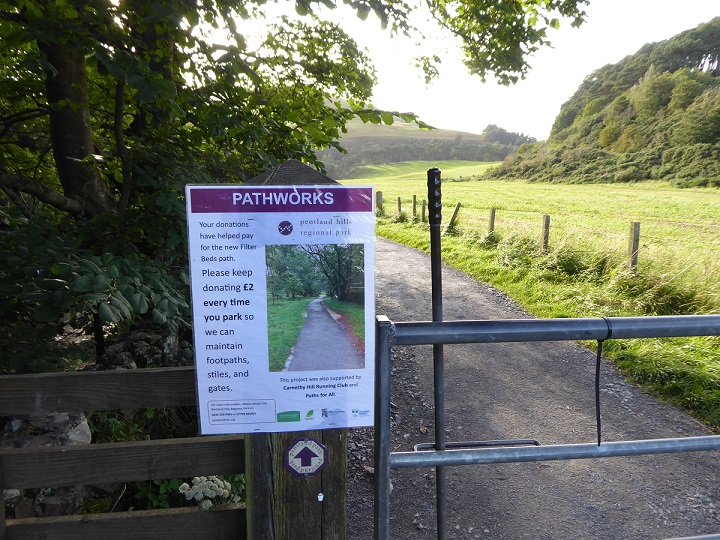
In September I visited the Pentlands Regional Park twice and was quite concerned about how access was being managed in response to the influx of people into the countryside.
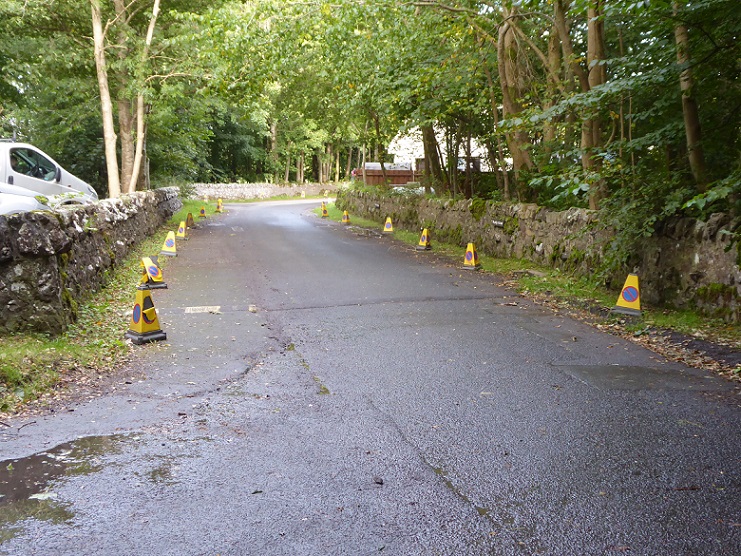
Parking was restricted, toilets closed and there was a proliferation of “no” signs (see here). Apart from some quite helpful signage about social distancing and one way systems from the car parks, little was doing to help people. I commented how Regional Parks in Scotland were being slowly strangled (see here).
To their credit, what remains of the Pentlands Regional Park Authority (RPRPA) has responded to the predicament of having too few resources to manage visitors effectively by developing proposals for new visitor infrastructure and to address funding shortfalls (see here):
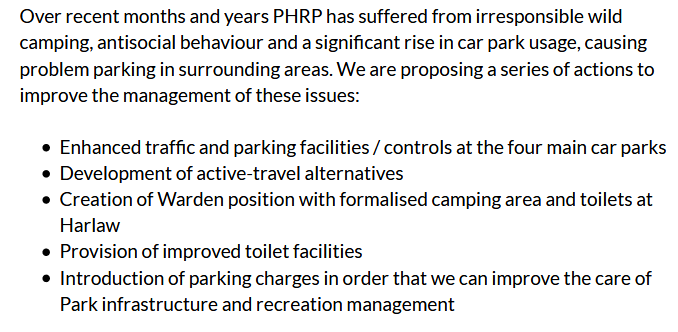 The PRPA are now consulting publicly on their proposals until 4th December (online survey here). This is very welcome and contrasts with the way the Loch Lomond and Trossachs National Park Authority (LLTNPA) have arrived at similar decisions. The LLTNPA, for example, never consulted publicly on their plans – now three years behind schedule – to introduce car parking charges. The LLTNPA refuses to record its meetings to allow more people to see what it is up too, while the PRPA meeting that agreed to the consultation is available as a webcast (see here). While long, at over 1 hour 40 mins, the webcast is worth dipping into to see very different views being expressed and see the pressures the Regional Park is under (including from billionaire landowner Alistair Salvesen and the local National Farmer’s Union rep). Again this is unlike in the LLTNPA where, even when Board Members ask questions and raise issues, they invariably end up rubber stamping the recommendations of staff. Here is a Regional Park Authority, starved of funds, showing the way to a much better funded National Park Authority.
The PRPA are now consulting publicly on their proposals until 4th December (online survey here). This is very welcome and contrasts with the way the Loch Lomond and Trossachs National Park Authority (LLTNPA) have arrived at similar decisions. The LLTNPA, for example, never consulted publicly on their plans – now three years behind schedule – to introduce car parking charges. The LLTNPA refuses to record its meetings to allow more people to see what it is up too, while the PRPA meeting that agreed to the consultation is available as a webcast (see here). While long, at over 1 hour 40 mins, the webcast is worth dipping into to see very different views being expressed and see the pressures the Regional Park is under (including from billionaire landowner Alistair Salvesen and the local National Farmer’s Union rep). Again this is unlike in the LLTNPA where, even when Board Members ask questions and raise issues, they invariably end up rubber stamping the recommendations of staff. Here is a Regional Park Authority, starved of funds, showing the way to a much better funded National Park Authority.
I also liked the openness of staff. They said it straight, that the problems of the Regional Park stem from cuts in funding from Edinburgh City Council and the other member councils. When people started in their thousands to visit the countryside after release of lockdown the PRPA had only enough resource to pay for one Ranger to be on at weekends and totally insufficient resources to empty the overflowing bins. They ended up having to call the police in to help manage the issues – the wrong solution. The scale of the problem is illustrated by staff conducting an access audit a few years ago and identifying the need for £2-3m investment. Nothing happened, mainly it seems because the national lottery had run out of funds.
The Scottish Government, however, has created its very own rural lottery, in the form of the Rural Tourism Infrastructure Fund (see here):
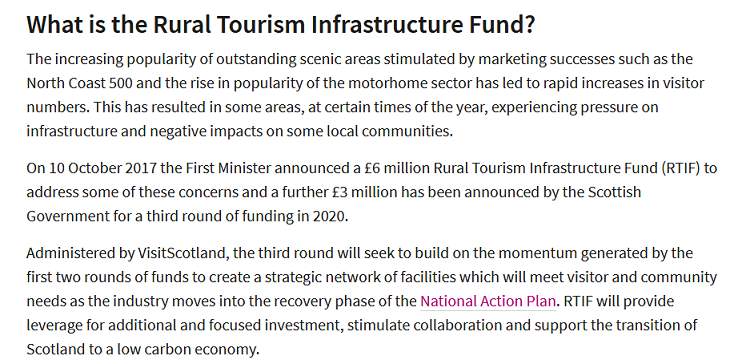
The idea that £6m was sufficient to address the cumulative lack of investment in Scotland’s rural tourism infrastructure was head in the sands stuff, designed to distract from the real issues, among which is why Visit Scotland spends huge sums of money marketing Scotland (over £40m a year) while investing almost nothing in facilities to support tourism The RTIF has been topped up this year but ,as Councillors in the Highlands have recently observed (see here), the funding is not even enough to address the pressing issues there and Councils have no alternatives as the Scottish Government hold all the purse strings.
It is within this context that PRPA staff have submitted their bid to the RTIF, with no time because of the deadlines to consult properly beforehand. The whole process is very time-consuming and staff stated the competition will be fierce. Large amounts of what capacity there remains to manage visitors in the countryside is now wasted chasing grants.
The PRPA’s proposals for capital investment to improve parking provision, increase the number of public toilets, create a new camping area and improve path links to car parks generally appear sensible.
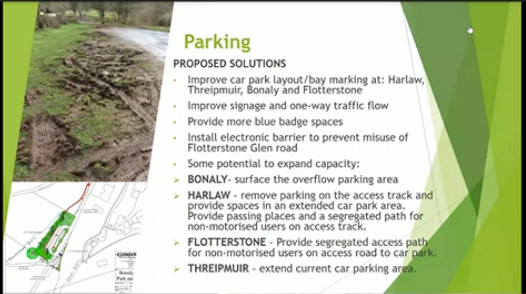 Most of the car park proposals, with the exception of Threipmuir, involve improving existing layouts rather than increasing capacity. As the PRPA acknowledged the fundamental issue that needs to addressed is how to enable people to access the Regional Park by public transport.
Most of the car park proposals, with the exception of Threipmuir, involve improving existing layouts rather than increasing capacity. As the PRPA acknowledged the fundamental issue that needs to addressed is how to enable people to access the Regional Park by public transport.
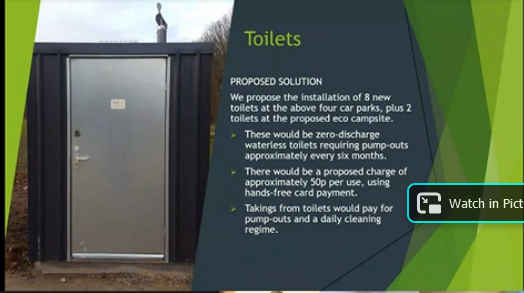
It was interesting to see the proposals for zero-discharge waterless toilets, a more permanent solution to the mobile toilets advocated on parkswatch (see here).
While there will be debate about the detail, the need for capital investment is not the main issue, even if the Deputy Convener of the PRPA questioned if anything would “work”. The main issue, I believe, is the ongoing lack of revenue funding. To address this the PRPA is proposing to introduce charges for using the new/upgraded facilities: toilet charges to cover their operation and car park charges to bring revenue into the Regional Park, for example to pay for additional Rangers.
The implications and potential consequences are wide-ranging. To work, people need to be forced to use the car parks, which means lots of double yellow lines and clearway orders in the surrounding areas. These would then need to be enforced, a cost for someone else. Local residents from Balerno raised the issue of why they should be charged for accessing what is effectively their local greenspace at Harlaw. If local residents get season passes that effectively is a large chunk of the revenue lost. The proposal to outsource the collection of charges, again more expense, had not been thought through. That this is not simple is suggested by the fact that three years later the LLTNPA’s much vaunted Automatic Number Plate Recognition system is still not in place. In sum there are strong reasons to believe that the cost of introducing car park charges, might result in very little if any net benefits. Unfortunately, following the steps of the LLTNPA, the PRPA appears to have made no attempt at a cost benefit analysis.
Possibly the reason for this is the PRPA staff cannot see any other options. They know that as long as their member Councils are on their knees financially, they won’t get any more funding. Facing financial collapse, they have been driven to suggest that those enjoying the Regional Park should be forced to pay for it. Austerity has been used to extend the scope of commercialisation to include our rights to enjoy the countryside. That fits with the neo-liberal world view that the state should provide as little as possible. The iniquitous impact of this was encapsulated by one attendee at the meeting who suggested car park charges should be increased to £10 in order to sort out who really wants to visit.
In a rational world, where people were allowed to consider solutions to problem that were not based on neo-liberal ideology it would be much simpler and fairer to fund bodies with responsibility for managing the countryside so they could do their job properly, without having to fight for pitiful amounts of grant funding or charge for access. Unless and until the Scottish Government recognise the need for both significant capital investment and revenue funding to manage visitor impacts in the countryside, the problems we saw this summer will continue. When it considers the results of its consultation, the PRPA should be brave enough to develop a plan which sets out the resources it really needs. It should then inform the Scottish Government about this so they can no longer hide behind the Rural Tourism Infrastructure Fund.

We have found car park charges can be both fair and effective at revenue raising.
we undertook consultation first with stakeholders.
findings:
introduce a quid pro quo- improved facilities;
have one day a week free, for folk time rich cash poor;
have a season ticket for frequent users;
minibus rate is less than 2 cars rate to support group use;
poll for appropriate daily fee (now £3p.d per car);
ensure income is visibly hypothecated.
It is significant to note: a £5.00 hike on annual road fund duty (otherwise known as car tax) across UK would raise approx £100 million each year. (This small levy gives an instant and proportionate overview of how much motorists are already required to pay annually just to own a car to be used on the UK roads. This without even beginning to look at fuel, servicing VAT and insurance taxation). Most car owners would hardly notice a small extra Road fund levy each year and I speculate many would not mind, provided the purpose of it was ringfenced and properly and honestly publicised for the “greater national good”. This annual levy might then be entirely devoted to funding infrastructure like free public car parks in National Parks and national scenic areas for those who pass through them.The benefit to national health and well being everywhere would be huge. Infinitely larger than all these inefficient and hostile, “for profit” agency ranger monitored, pay- as –enter car parks which everyone everywhere detests and which siphon funds away while achieving so little improvement to public well being. Why ever not ?
Yip Tom,
Of course that £5 along with a number of others could compulsory purchase say 10 acres plant with concrete and
Tarmacaddam for that one Sunday afternoon every year where the seething masses elect to head to that (what was) a lovely quite glen, now dotted with camper vans and detritus of a life which never was (and hopefully never will) been expected to see.
The other 51 weekend of the year it will be a fantastic concrete and tarmacadam pad. Lovely.
#austerityofbrains #buildandtheycome #donotstillappear
So, having complained about people parking in front of farm gates in comments on previous posts, I would be interested in hearing what are your solutions for people wanting to visit the countryside?
Big Yellow Taxi or Field of Dreams?
So what is the capacity of our landscapes or indeed cityscapes then Nick?
This is really the nub of the issue is it not?
So let’s say folk are parking in gateways, is it because they are lazy or roadsides are at capacity?
I can assure in my own circumstances it was because the perps were lazy, however I and surely you are aware that a number of single tracked glens here in Angus were absolutely rammed with with folk and their cars, as it was elsewhere.
Now I am fortunate as I work,live and enjoy recreation in the country. Even luckier that I can enjoy my recreation at a good distance from honeypots which have been long established and have sprung up this summer.
And yet if I come to town, say Glasgow, there is a fairly reasonable expectation on my part that I will have to pay for pay for parking or be fined if I were to arrive in a period where there was no on street parking at a honeypot. And no I would not be as rude as to park in the gateways of others.
So it hits a capacity but some seem to think we can keep building more hard standing etc at no cost directly to them and charging to use these facilities is terrible in rural areas. Camper vans and campsites spring to mind.
Anyway could chew the fat on it but in essence pay your way until capacity.
Could be interesting when road pricing comes into play.
S……maybe you misunderstand . Asking people to pay on entry is so very inefficient. the small seasonal revenue that might accrue annually barely covers the”fixed” costs associated with collection. Yet plenty of hard standing possibilities exist near to all the roadsides right across Scotland. The problem for land owners is the bureaucracy of the current planning system, and a total lack of incentive. This leave frams and estates totally unwilling to permit the public to use spots that until 70 years ago were never fenced off. Those traditional routes between regions , free for use under Scotland’s ancient droving and stock movement codes. A £100 million fund every year perhaps related to acreage freed up for public recreational parking access paid to the title holder would provide just such an incentive. I refer to existing- some very ancient- access roads to hillsides; existing timber marshalling and hardstanding areas laid down to allow for machinery use to fell and extract and then replant forestry blocks; old farmyards no longer economic or too constricted for modern contract farming operations, former small rural industrial sites, old pylon, waterworks and public utility access areas within villages and now today huge new back filled “borrow pit “yards adjacent to hundreds of wind farms , now no longer occupied by contractors plant. Literally hundreds of places. Each one that was opened up would reduce “footfall” on all the others. The problem for road users touring Scotland today is a total “them and us” attitude by most owners of land, combined with complete lack of incentive given by authority to share any part of what they own. Partly this is a consequence of a lack of imagination by politicians and regional plannersbut in the main it is because too few see any need to consider the “greater good for all”, unless a real whiff of personal profit for minimal effort is in the air. Until a mechanism to reverse this trend appears nothing will change. The £100 million PA levy fund I suggested to support access /parking in national parks and national scenic areas could modify attitudes to the informal opening up privately held parcels of “brown field” land right across the highlands. Such a fund could be tied into satellite monitoring of levy subsided areas pressed into use, and help change attitudes towards ” free enjoyment” of the countryside, permanently.
Watched this the other night and it was clear that there were concerns of over pressure on local areas from tourists.
Admittedly trickier to get there for a weekend than much of periphery central belt areas, but similar experiences.
https://www.bbc.co.uk/iplayer/episode/m000qf0c/the-misadventures-of-romesh-ranganathan-christmas-the-hebrides
https://www.bbc.co.uk/news/uk-scotland-highlands-islands-56209550